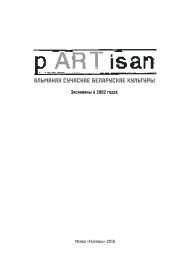pARTisan_32
You also want an ePaper? Increase the reach of your titles
YUMPU automatically turns print PDFs into web optimized ePapers that Google loves.
agrotown. If I had decided to live there myself, I would have to say<br />
goodbye to all my dreams, which are now, by the way, gradually<br />
turining into reality. In the agrotown the pace of my life would be<br />
quiet and slow, I would be caught up by the everyday routine, but,<br />
on the other hand, maybe I would be happy in something else."<br />
The project, which at first glance may seem a simple documentation<br />
of the agro residents’ everyday life, poses present and future<br />
generations of the Belaruisans questions of a much higher order<br />
where the key issue is certainly that of making life choices. Together<br />
with choosing between the city and the pseudo «agro»-comfort,<br />
the young people choose between struggle, desire for change,<br />
movement, on the one hand, and submissiveness, «a parent comfort<br />
zone» and stability — on the other, which are virtually synonymous<br />
to stagnation. Since the city in today’s realities is not only constantly<br />
changing rules of the survival game, but also a rich cultural life, new<br />
contacts and a plenty of opportunities for growth.<br />
When looking at the «Agro» images, we seem to be travelling back<br />
in time a couple of decades ago on the invisible time machine.<br />
Here is a woman in plastic slippers worn barefoot who is checking<br />
zucchini, here are the children sitting under the Orthodox icon in the<br />
plush chair, or a girl in a pink sports uniform with a dog on a leash.<br />
The world of «agro» froze in the hibertation mode «until better<br />
times», clearly showing the triumph of stability. The exceptions,<br />
and together with them the hopes for change, appear only in a few<br />
pictures, and among them there is «a visiting card» of the project —<br />
a sort of the ceremonial portrait with a serious and at the same time<br />
gentle couple of the young people from Zaskavichi posing against<br />
the background of a new car.<br />
Will reaching the stage of financial stability become a prerequisite<br />
for moving to the next level of needs? Will the young couple drive<br />
this car to the city in search of something else? Will a new culture of<br />
«agro-generation» get born on the ruins of the abandoned village<br />
«dom kultury», and what will it look like then? Time will answer these<br />
questions. In the meantime, in Siarhiej Leskiec’s photos next to the<br />
Orthodox icon above the heads of the kids in a plush armchair there<br />
is a wall clock hanging and the time it shows has got frozen.<br />
Сяргей Лескець. Агра, фотапраект. 2013–2015. З архіву аўтара<br />
Siarhej Leskiec. Agro photo-project. 2013–2015. From the author’s archives<br />
41





